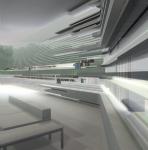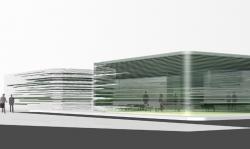Rather than lamenting the disappearance of the book, the mediatheque project celebrates the opportunity to use space to experience the spectrum of available information from printed books to digital media and computerized information retrieval systems.
In contrast to the traditional library where the books and bookshelves wrap around a room creating the space for reading, contemporary libraries are often an independent grid of shelves organized within a large room. The mediatheque we propose returns to the traditional library concept where there is no separation between the walls and the book; the bookshelves wrap around the exterior surface to create the space.
The program called for 500 linear meters of storage space for books, periodicals and other media, such as CD-Roms and DVDs. In order to define the different areas of activity into spaces for adults, children, reading, lectures and offices, we developed a bookshelf strip which was compressed and folded within the space. The bookshelf element acts as both a storage space for books and digital media and a structural wall which encloses and subdivides the space.
The wall was constructed by stacking glass and concrete blocks, creating an uncertain boundary between the interior and exterior landscape. The walls blur from a mostly opaque element, protecting the books from the sunlight, to a light, transparent wall where the digital information can be accessed. Parts of the wall act as retrieval devices for digital information allowing the visitor to use the architectural structure and interact with information.
2003




.jpg)
